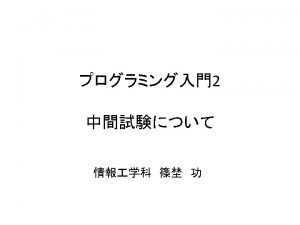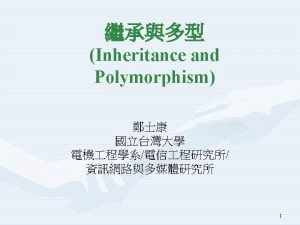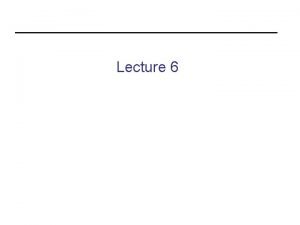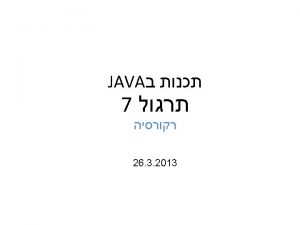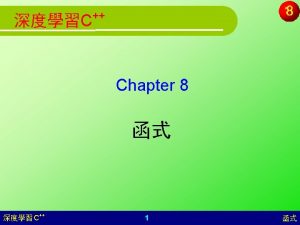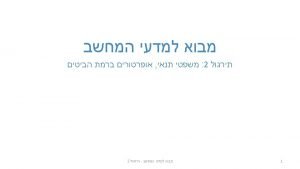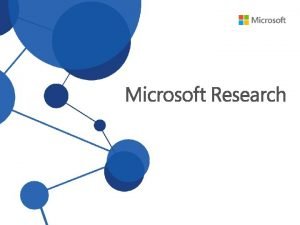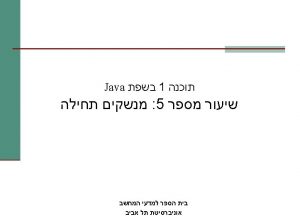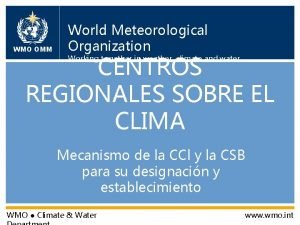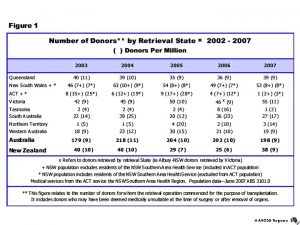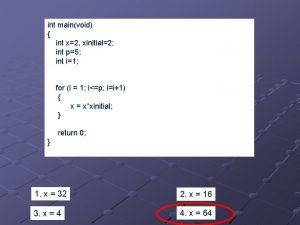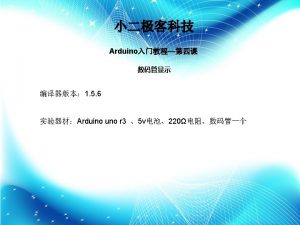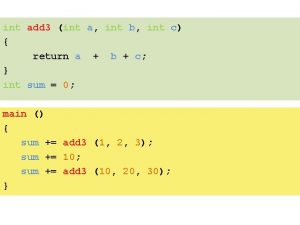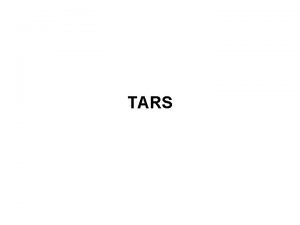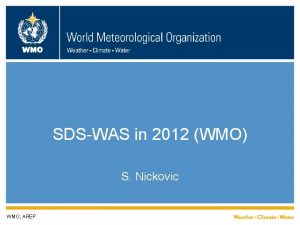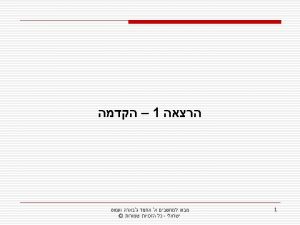WMO Codes Registry http codes wmo int Task


















- Slides: 18

WMO Codes Registry: http: //codes. wmo. int Task Team on Aviation XML Montreal, Canada, 7 -9 October 2013 Submitted by: Jeremy Tandy, Met Office WMO; Name of Department (ND) TT-Av. XML-3/Doc(15) Agenda Item 5. 7 02 October 2013

Overview of WMO Codes Registry § § § WMO Codes Registry provides web-based publication of authoritative vocabulary for new data exchange standard WMO Av. XML enabling transmission of XML-encoded operational meteorological data for international air navigation (OPMET) as specified in ICAO Annex 3 Amd 76 (Nov 2013) Implemented with UKgov. LD Registry software using RDF and Linked. Data principles – open source (Apache 2 license) on Git. Hub Definitive source of terms is WMO No. 306 Manual on Codes and other WMO Technical Regulation Current coverage of WMO No. 306 is sparse as initial objective is support for WMO Av. XML; commitment from WMO to expand coverage Service operated on behalf of WMO by Met Office for initial 2 -years from September 2013 For further information, please refer to User Guide, FAQ and technical documentation

Overview of Registry concepts § § § Register: a single controlled collection (e. g. a list) maintained on behalf of some owner organization which provides the authority & governance regime for the collection Entity: a member of the controlled collection – the Entity type is completely open but may be constrained by the Register’s governance policy Sub-register: a Register may contain other Registers, enabling creation of arbitrarily complex sub-register hierarchies Register Item: a metadata record describing the relationship of an Entity to a given Register – the Register Item includes a graph of information properties that describe the Entity as determined by the Register manager enabling a local description of the Entity to be maintained within the Registry Data model is derived from ISO 19135 ‘Geographic information – Procedures for item registration’ – please refer to technical documentation for full details of the data model

Registry information views § § The Registry design assumes that the majority of users simply want to access the list of member entities for a given Register; a “Container view” is provided for this purpose A “full view” provides expert users with detailed item-level metadata … Relationship between Register, Entity and Register Item

Register Item status and lifecycle § § A Register Item has status within its associated Register Status is not intrinsic to the Entity but rather a statement of how the Entity is regarded by the Register’s authority Lifecycle is derived from ISO 19135 ‘Geographic information – Procedures for item registration’ Note that only Entities whose Register Item has status “Accepted” (& subtypes thereof) are regarded as members of the Register

History and versioning § § § The Registry service maintains an accessible history of changes to Registers and Register Items – including changes to the graph of information properties used to describe the Entity Concept management 101: it is essential that changes to the description of an Entity do not change its semantics; once allocated, the Entity’s identifier should always refer to the same concept – else data “in the wild” referring to that concept (e. g. using the identifier) may be rendered incorrect. Instead, deprecate the concept and introduce a replacement that supersedes it. Likewise, don’t delete concepts; mark them as retired For more information regarding history and versioning please refer to technical documentation

WMO Codes Registry web application & API § § § The WMO Codes Registry provides two forms of read and modify access: § Programmatic access via an API § Human readable access via a web application Details of the programmatic API can be found here, including a summary of the API operations Modification of Registry content requires authorization – external Identity Providers are used to authenticate via the Open. ID protocol (currently only Google is validated as a working Identity Provider, but other Open. ID providers may also work) § By default, HTML content is provided; this may be overridden using the _format={format} query parameter; content negotiation is also supported § § HTML: Turtle: RDF/XML: JSON-LD: text/html text/turtle application/rdf+xml application/ld+json ? _format=ttl ? _format=rdf ? _format=jsonld

Overview of web application navigation (i) § The figure below provides a generic overview of navigation within the web application; please refer to the User Guide (pg: 19 -30) for a more detailed review …

Overview of web application navigation (ii) 1. 2. 3. Link to root Register; provides quick access to top-level Registers Links to Registry functions Search facility to find resources within the WMO Codes Registry; based on textual properties of resources (e. g. label, description) 4. Link to user authentication page 5. “Breadcrumb” specifying the path to current Register; provides hyperlinks to parent Registers for quick access 6. Register or Entity label 7. Register or Entity description 8. Register or Entity status 9. Links providing data-download access for the current Register or Entity 10. Tabs providing information about the current Register or Entity 11. Sidebar providing quick access to supplemental information for the current Register or Entity 12. Information section; content varies depending on which tab is selected

Top-level Registers § § Top-level Registers in the WMO Codes Registry are aligned with WMO publications Currently, this includes: § § WMO No. 306 – Manual on Codes WMO No. 49 Volume II – Meteorological Services for Air Navigation Due to their frequency of use, top-level registers are also provided for terms drawn from WMO No. 306 – Manual on Codes – International Codes, Volume I. 2; FM 92 GRIB (edition 2), FM 94 BUFR (edition 4) and Common features Each top-level register is assigned a unique URI within the wmo. int domain: § § § WMO No. 306 WMO No. 49 -2 FM 94 BUFR (edition 4) FM 92 GRIB (edition 2) Common Features http: //codes. wmo. int/306 http: //codes. wmo. int/49 -2 http: //codes. wmo. int/bufr 4 http: //codes. wmo. int/grib 2 http: //codes. wmo. int/common

Leaf Registers § § § The WMO Codes Registry is organized into Sub-registers; where possible this is aligned with the organization of the WMO publications Each Sub-Register is assigned a unique URI – adding a further segment to the URI of the parent Register Leaf Registers represent the code-tables themselves; for example, table 0 20 086 “Runway deposits” from FM 94 BUFR (edition 4) Code- and Flag-tables has identifier http: //codes. wmo. int/bufr 4/codeflag/0 -20086

«Code. List» classes within Av. XML § The leaf Registers are bound to «Code. List» classes in the Av. XML Application Schema enabling the controlled vocabulary for Av. XML to managed outside the model. . .

Codes and associated concepts § § § The Entities within these leaf Registers are the concepts represented by the codes, whilst the codes themselves are implemented as the Register Items Where available, the numeric identifiers from the WMO code-tables are used as the Register Item ‘notation’ In the majority of cases, the unique URI for an Entity is assigned by appending the ‘notation’ to the identifier of the containing Register – thus ensuring clash-free allocation of identifiers; the Register Item identifier is distinguished from the Entity identifier by use of the underscore “_” syntax Register Item URI Entity URI

Externally managed Entities § § § In some cases, the Entity that is registered is defined elsewhere in the Registry – or perhaps defined by some external authoritative source In such cases the Register Item identifier is still allocated by appending the ‘notation’, prefixed with an underscore “_” character, to the identifier of the containing Register. However, the identifier of the Entity shall refer to the external definition For example, see the /common/nil Register that curates nil-reason codes: § § Register Item: http: //codes. wmo. int/common/nil/_Above. Detection. Range Entity: http: //www. opengis. net/def/nil/OGC/0/Above. Detection. Range

WMO TDCF encoding details (i) § § The Register Item provides metadata about how an Entity is used in the context of a specific Register. In the WMO Codes Registry, the Register Item represents the code rather than the concept represented by that code; For example, in FM 94 BUFR (edition 4) table B, the concept “dewpoint temperature” is referenced three times – each with different units of measurement and precision implied by the combination of ‘datawidth’, ‘reference value’ and ‘scale’. § Concept: http: //codes. wmo. int/common/c-15/me/dew. Point. Temperature § § § Code: http: //codes. wmo. int/bufr 4/b/12/_003 Code: http: //codes. wmo. int/bufr 4/b/12/_024 Code: http: //codes. wmo. int/bufr 4/b/12/_103 Note the underscore “_” syntax designating them as Register Items. test footer 15

WMO TDCF encoding details (ii) § Each of these Register Items are configured with details about how the concept “dew-point temperature” is used in each context; e. g. the specific encoding information associated with each code. That is: § § § BUFR_Data. Width_Bits BUFR_Reference. Value BUFR_Scale BUFR_Unit These properties are defined in the FM 94 BUFR ‘schema’ Subregister: http: //codes. wmo. int/bufr 4/schema/core/BUFR_Data. Width_Bits http: //codes. wmo. int/bufr 4/schema/core/BUFR_Reference. Value http: //codes. wmo. int/bufr 4/schema/code/BUFR_Scale http: //codes. wmo. int/bufr 4/schema/code/BUFR_Unit § A similar mechanism is provided for capturing WMO-specific metadata for codes within FM 92 GRIB (edition 2) and Common Features. test footer 16

Register membership validation mechanisms § The WMO Codes Registry provides validation via both web application and programmatic API § In the case of the web application, one simply enters the URI of the term to be validated in the form-field and selects “check” … § Alternatively, the programmatic API may be used to achieve the same result by way of a HTTP POST request; e. g. § [POST] http: //codes. wmo. int/bufr 4? validate=http: //codes. wmo. int/bufr 4/codeflag/0 -20 -086/1 § [HTTP 200 OK] http: //codes. wmo. int/bufr 4/codeflag/0 -20 -086/1 is http: //codes. wmo. int/bufr 4/codeflag/0 -20 -086/_1

Thank you for your attention For further information please refer to the User Guide, FAQ and technical documentation www. wmo. int
 Int sum(int a int n) int sum=0 i
Int sum(int a int n) int sum=0 i Interface calculator public int add class test
Interface calculator public int add class test Public void drawsquare(int x, int y, int len)
Public void drawsquare(int x, int y, int len) Public int divide(int a int b)
Public int divide(int a int b) Int max(int x int y)
Int max(int x int y) Const int arduino adalah
Const int arduino adalah Int b
Int b Int main int argc char argv
Int main int argc char argv Int main int num 4
Int main int num 4 Mainint
Mainint #include stdio.h void main()
#include stdio.h void main() Voidswap
Voidswap 7팩토리얼
7팩토리얼 Int f (int n)
Int f (int n) Interface myinterface int foo(int x)
Interface myinterface int foo(int x) Tiered task bias task
Tiered task bias task Siat ung sistem informasi akademik
Siat ung sistem informasi akademik Http //mbs.meb.gov.tr/ http //www.alantercihleri.com
Http //mbs.meb.gov.tr/ http //www.alantercihleri.com Omm wmo
Omm wmo
